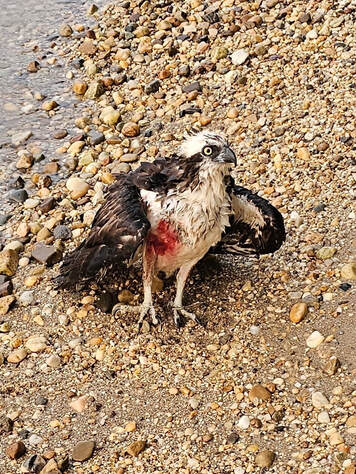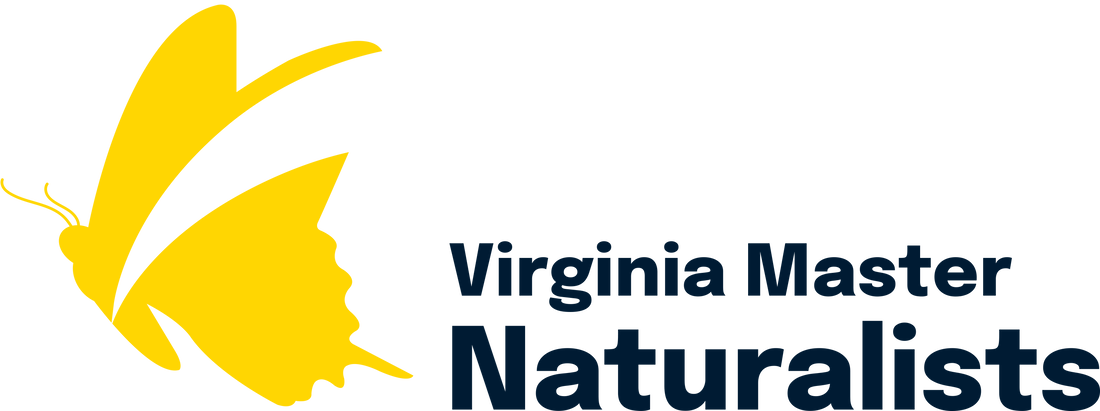 The osprey was clearly injured. Photo by Jenna Villforth Veazey.
The osprey was clearly injured. Photo by Jenna Villforth Veazey. --By Jenna Villforth Veazey, VMN volunteer, Central Rappahannock Chapter
Enjoying ospreys flying over the river is a pretty common pastime from my house.
But the other day, when I caught sight of one circling over what I thought was a fish flopping on the surface of the water, I had to look twice! That was no fish...it was a second osprey! And it appeared to be struggling not to drown. With binoculars, I saw how it couldn’t lift its wings fully out of the water.
Not thinking there was much I could do at this point, I noted that the osprey was drifting downriver with the tide, but slowly. Knowing I had a tandem sit-on-top kayak near the riverbank I decided that I had to at least try to help.
First rule in any "rescue" on the water is to make sure you, yourself, do not become a liability. So, I called to my adult son, “Wanna go on a crazy adventure...like, now?" all while grabbing safety gear for ourselves, plus an old blanket in case we had to handle the bird. Even as we got the kayak into the river, I kept thinking…now what?!! Despite being an experienced kayaker and trained in self-rescue, I wasn't super eager to bring a floundering, adult osprey on board! But I thought, if nothing else, getting a closer look would help me assess the situation better.
Thankfully, the osprey appeared calm while it floated (despite the fact that it clearly couldn’t get itself out of the water). I noted that it’s attempts to fly were pushing it in the direction of the shore. Keeping our distance (so we didn’t cause it more distress), we just kept an eye on it and used our kayak to keep it from drifting out into the main channel of the river. This way the osprey was able to naturally float to shore without interference.
But once it made it to the beach, it just hunkered down, shivering. We continued to keep a watchful eye, hoping it could rest and recover. It was nearing dark and we have a resident great horned owl and family of fox that patrol the riverbank on the regular, no way was I leaving an exhausted, possibly injured osprey unprotected. But it wasn’t until I spotted blood on its feathers that I knew an intervention was absolutely necessary.
I reached out to my fellow chapter Master Naturalists as well some State Park Ranger friends. After a flurry of texts and phone calls, I was put in touch with a wildlife rehab transporter. It was close to dark, so per the volunteer's directions, my son and I carefully cloaked it in a towel and set it in a box to rest in our quiet garage to await transport the next morning.
The next a.m. we were contacted by yet another wonderful volunteer who picked up the osprey and drove it to the care of Belinda Burwell, D.V.M. with Wildlife Veterinary Care.
After a few days, we got the news the osprey was able to be released! Dr. Burwell informed us that the osprey was a SHE, and that she'd suffered from a puncture wound.
A new set of wonderful volunteers drove her back to the same spot we'd recovered her from and were on hand to make sure her return to the wild was a complete success. I was thrilled that both my son and I were home to witness the release!
Getting to watch her fly from her travel crate (see video below), and eventually land safely up-river to preen and re-oil her feathers—what a happy moment that was!!
--Editor's note: The author, Jenna, has another neat project she organized, Poetry on the Trail, which offers users of the Dahlgren Railroad Heritage Trail in King George County the opportunity to connect with nature through poems by Virginia writers. Learn more at http://www.poetryonthetrail.org/news.
Enjoying ospreys flying over the river is a pretty common pastime from my house.
But the other day, when I caught sight of one circling over what I thought was a fish flopping on the surface of the water, I had to look twice! That was no fish...it was a second osprey! And it appeared to be struggling not to drown. With binoculars, I saw how it couldn’t lift its wings fully out of the water.
Not thinking there was much I could do at this point, I noted that the osprey was drifting downriver with the tide, but slowly. Knowing I had a tandem sit-on-top kayak near the riverbank I decided that I had to at least try to help.
First rule in any "rescue" on the water is to make sure you, yourself, do not become a liability. So, I called to my adult son, “Wanna go on a crazy adventure...like, now?" all while grabbing safety gear for ourselves, plus an old blanket in case we had to handle the bird. Even as we got the kayak into the river, I kept thinking…now what?!! Despite being an experienced kayaker and trained in self-rescue, I wasn't super eager to bring a floundering, adult osprey on board! But I thought, if nothing else, getting a closer look would help me assess the situation better.
Thankfully, the osprey appeared calm while it floated (despite the fact that it clearly couldn’t get itself out of the water). I noted that it’s attempts to fly were pushing it in the direction of the shore. Keeping our distance (so we didn’t cause it more distress), we just kept an eye on it and used our kayak to keep it from drifting out into the main channel of the river. This way the osprey was able to naturally float to shore without interference.
But once it made it to the beach, it just hunkered down, shivering. We continued to keep a watchful eye, hoping it could rest and recover. It was nearing dark and we have a resident great horned owl and family of fox that patrol the riverbank on the regular, no way was I leaving an exhausted, possibly injured osprey unprotected. But it wasn’t until I spotted blood on its feathers that I knew an intervention was absolutely necessary.
I reached out to my fellow chapter Master Naturalists as well some State Park Ranger friends. After a flurry of texts and phone calls, I was put in touch with a wildlife rehab transporter. It was close to dark, so per the volunteer's directions, my son and I carefully cloaked it in a towel and set it in a box to rest in our quiet garage to await transport the next morning.
The next a.m. we were contacted by yet another wonderful volunteer who picked up the osprey and drove it to the care of Belinda Burwell, D.V.M. with Wildlife Veterinary Care.
After a few days, we got the news the osprey was able to be released! Dr. Burwell informed us that the osprey was a SHE, and that she'd suffered from a puncture wound.
A new set of wonderful volunteers drove her back to the same spot we'd recovered her from and were on hand to make sure her return to the wild was a complete success. I was thrilled that both my son and I were home to witness the release!
Getting to watch her fly from her travel crate (see video below), and eventually land safely up-river to preen and re-oil her feathers—what a happy moment that was!!
--Editor's note: The author, Jenna, has another neat project she organized, Poetry on the Trail, which offers users of the Dahlgren Railroad Heritage Trail in King George County the opportunity to connect with nature through poems by Virginia writers. Learn more at http://www.poetryonthetrail.org/news.
The volunteer who rescued the osprey was able to help release her at the same spot once she was recovered.
[Alt text: Three individuals release an osprey from a crate, and it flies away over the water.]
[Alt text: Three individuals release an osprey from a crate, and it flies away over the water.]



 RSS Feed
RSS Feed